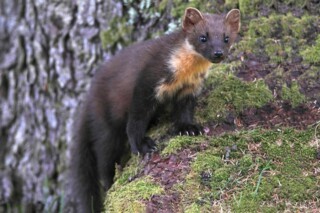Return of the Pine Marten
Quentin Shaw
In September a camera trap monitoring hedgehogs in Kingston upon Thames caught an astonishing snap of a pine marten, the most elusive of English mammals. There had been no confirmed sightings in England for a century until July 2015 when a naturalist in Shropshire took a photo. There, gambolling in broad daylight, was an animal from the wishful world of cryptozoology, a fantastic beast, previously no more substantial than a plesiosaur in Loch Ness or a big cat in Surrey.
There had been fleeting hints: a strange animal in the headlights on the A49, something scampering in the trees while a forester ate their sandwiches, but hard evidence was always lacking. Volunteers had cycled around country lanes scraping up roadkill and deep-freezing the flat carcasses for later identification, only to find that they were all polecats or mink. People had sniffed and handled strange scat, which turned out to be from foxes and badgers. But now we knew there was at least one marten out there in Shropshire. A massive ongoing programme of camera traps has since revealed about a dozen more. Once in a thousand video clips there is a fleeting glimpse, usually of a marten already half out of shot before the camera triggered.
Pine martens in other countries are much more prosaic. In Scotland they raid hen houses and birdboxes, make dens in outbuildings and have been tempted into houses. Some will eat from your hand. They mark their territories by extravagantly defecating as they run, leaving their long thin scats in alphabetic shapes like thrown apple peel. Despite the hours of searching, no one has yet found a scat in Shropshire. This is frustrating, as scat DNA analysis would allow us to work out whether the Shropshire martens are a genuine relict ‘English’ population or more recent immigrants from Wales.
There was a time after the last Ice Age when pine martens thrived all across the British Isles. The standard narrative is that they were persecuted to extinction in England by gamekeepers. The truth may be simpler, and in some ways sadder. Unlike other Mustelidae (such as weasels, badgers, otters, stoats and polecats), pine martens are arboreal, and can only breed in suitable den holes in ancient trees. Since the Neolithic period, we have been destroying our forests. Deprived of dens, the pine martens retreated to the next best thing: rocky crags. They lasted in Snowdonia and the Lake District longer than most places, and survived into the present in the mountain fastness of north-west Scotland.
The turn of the last century, the era of the evil gamekeepers, also happened to be the low point for tree cover in the UK. Things have improved since, but we still average only 13 per cent cover, compared to 30 per cent for France or Germany, where pine martens thrive.
As well as a lack of den sites, pine martens in England face another difficulty. Out in the open, away from trees, they fall prey to foxes. They don’t have the anal glands to produce the stink defence used by polecats and other mustelids to repel attackers. In the distorted world of our managed landscape there are no apex predators such as wolves, bears or lynxes. The mesopredators – foxes, badgers and pine martens – are ‘released’ to compete for the top slot, and the martens lose. They aren’t even in direct competition with the foxes, living largely off insects, eggs and fruit – though the foxes aren’t to know that, and are only doing the sensible thing by killing off what appears to be a rival carnivore.
Martens take three years to reach sexual maturity and only produce two kits per litter (a relatively low number for a mustelid). Life expectancy in the wild may be less than five years. Left to their own devices, it would take the population a long time to recover in England. We cannot help them by conjuring ancient trees into existence, but we can put up den boxes in plantations as a substitute.
It's also possible they’re getting a quiet boost from an unexpected direction. In 2014, Emma Sheehy produced evidence for a dramatic crash in the population of grey squirrels in Ireland when pine martens returned. And, as the grey squirrels declined, the red squirrels recovered. It seems that the grey squirrels, having evolved in areas of North America where there are no martens, are vulnerable to predation, unlike the co-evolved reds. The web of niche competition is tightly meshed: the martens do to the greys what the greys do to the reds and the foxes do to the martens.
Sheehy’s finding is good news not only for red squirrels but for the world of commercial forestry. Grey squirrels do enormous economic damage, killing and deforming trees by stripping the bark. Now a curious thing is happening: pine martens have started appearing in the south of England. I suspect that foresters are secretly importing them from Scotland, and the marten photographed in Kingston is probably one of these guerrilla reintroductions.

Comments
Ainley Hayden
Steamboat Springs, Colorado.